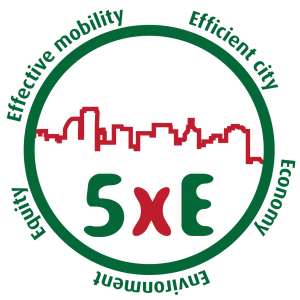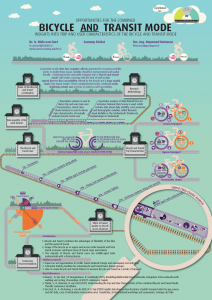Posted in September 2017
Opportunities for the Combined Bicycle and Transit Mode
Around the world cities face negative effects generated by increasing mobility needs. To tackle these issues, mobility should be environmental and spatial friendly. Combining bicycle and public transport into a ‘bicycle + transit mode’ will create a synergy with the best of both worlds: superb door-to-door accessibility offered by the bicycle and a large spatial reach from transit modes. These complemented modes combined easily challenge private carsin terms of speed as well accessibility.
Research regarding the users and trip types of the bicycle and transit mode is largely missing. This is unfortunate, since understanding both user and trip characteristics is of the utmost importance to improve the share of the bicycle and transit mode. Policy-makers can make concrete decisions on infrastructure and service investments only when the gap between the aforementioned societal need and scientific knowledge is filled.
The main analysis in the study is based on data from the Netherlands. The Netherlands is one of the countries with a head start regarding the use of the bicycle + transit mode. A one-day trip diary survey, representative of the population of the Netherlands, with more than 250,000 respondents who made nearly 700,000 trips over the course of 6 years (2010-2015), is used to derive important trip and user characteristics of the bicycle + transit mode. Finally, latent class cluster analysis is applied to find prototypical users of this mode on the basis of their socio-demographic attributes.
It is, for example, found that the most important purposes of the bicycle and transit mode are work or education, typically involving relatively long distances. Bicycle and transit-potential for other transit network levels, such as metros and bus rapid transit can be found. Moreover, seven unique user groups – from middle-aged professionals to school children – are identified, and their different travel behaviour is discussed.
The wider benefits of high quality of public transport for cities
The full value of public transport is often underestimated. The 5E framework, consisting of effective mobility, efficient city, economy, environment and equity supports assessing and quantifying this value. This paper presents the framework and a wide selection of sources illustrating the wider benefits of high quality of public transport for cities.
Find our ETC conference paper HERE

Vacancy: PhD: Public Transport Data Analysis & Modelling
We are looking for a new PhD candidate in our PT research team. Click on the vacancy below or check HERE
Performance assessment of fixed and flexible public transport in a multi agent simulation framework
The emergence of innovative mobility solutions that offer flexible transport services, is changing the way urban public transport systems will be designed. Such mobility solutions offer on demand transport services and hence can solve the problems inherent with traditional line based and schedule based public transport systems. It is essential to understand the dynamics of this new demand-supply market with co-existing and competing fixed and flexible public transport. However, the performance of the system comprising of users and transit services and the factors influencing them, have received limited attention in literature. In this paper a model is developed to analyse the system performance when the modes of fixed public transport and flexible public transport operate in competition. The model is implemented in the multi-agent simulation framework MATSim with dynamic assignment in which the users optimize their travel plan through iterative learning from the service experienced and altering their travel plan. The scenarios in which the flexible public transport offer private and shared services are considered. The system performance is analysed for varying fleet size of flexible public transport and ratio of cost of flexible to fixed public transport.
Find the paper HERE
Data-driven transfer inference for public transport journeys during disruptions
Disruptions in public transport have major impact on passengers and disproportional effects on passenger satisfaction. The availability of smart card data gives opportunities to better quantify disruption impacts on passengers’ experienced journey travel time and comfort. For this, accurate journey inference from raw transaction data is required. Several rule-based algorithms exist to infer whether a passenger alighting and subsequent boarding is categorized as transfer or final destination where an activity is performed. Although this logic can infer transfers during undisrupted public transport operations, these algorithms have limitations during disruptions: disruptions and subsequent operational rescheduling measures can force passengers to travel via routes which would be non-optimal or illogical during undisrupted operations. Therefore, applying existing algorithms can lead to biased journey inference and biased disruption impact quantification. We develop and apply a new transfer inference algorithm which infers journeys from raw smart card transactions in an accurate way during both disrupted and undisrupted operations. In this algorithm we incorporate the effects of denied boarding, transferring to a vehicle of the same line (due to operator rescheduling measures as short-turning), and the use of public transport services of another operator on another network level as intermediate journey stage during disruptions. This results in an algorithm with an improved transfer inference performance compared to existing algorithms.
Find the paper HERE


